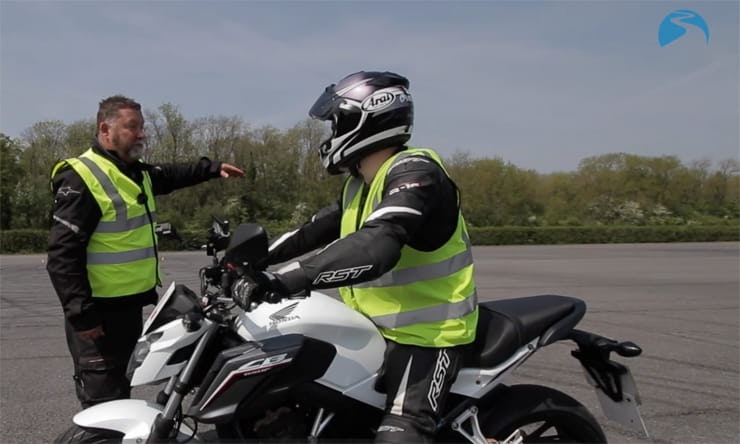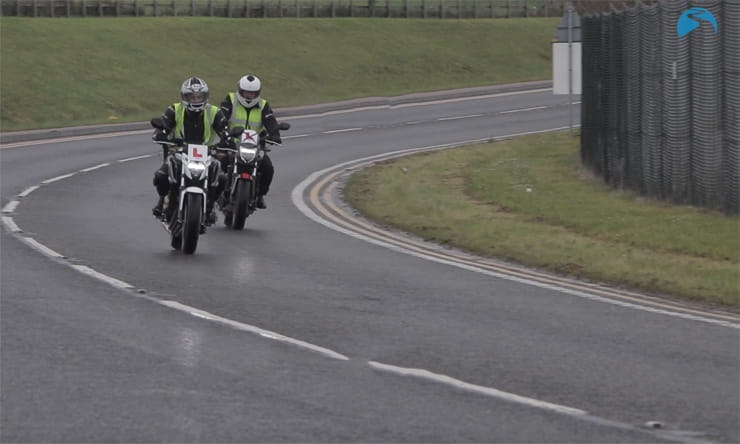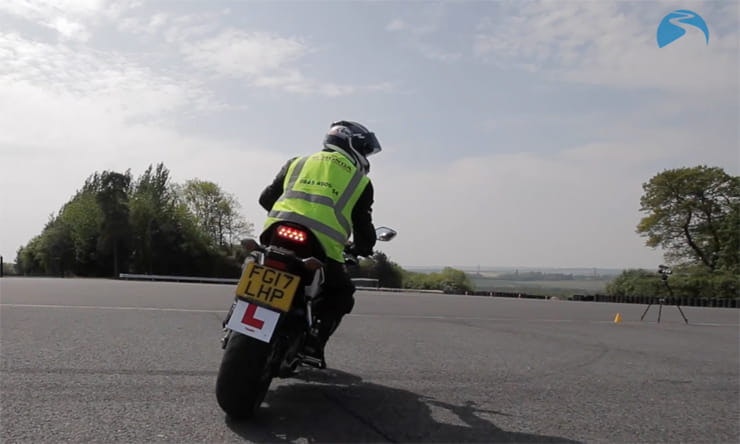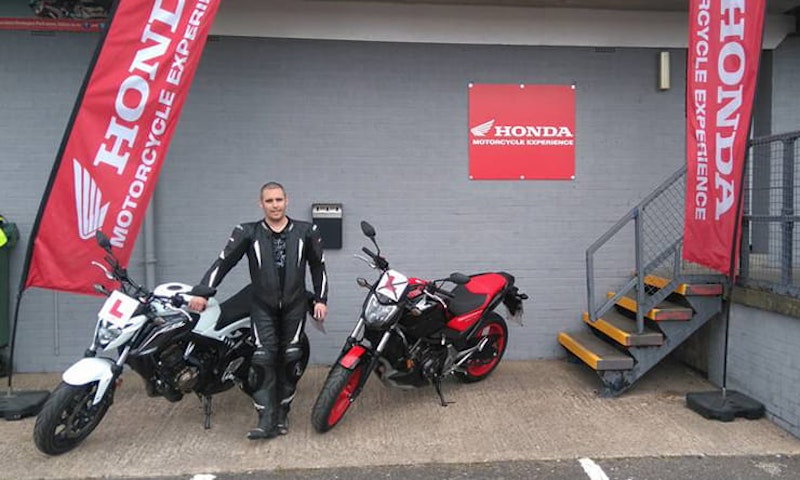How to pass your motorbike test
By Simon Hancocks
Motorcycle Journalist
12.07.2017
Leathers
Date reviewed: May 2017 | Tested by: Simon Hancocks | Price: £749 | http://www.hondamotorcycletrainingderby.co.uk/courses/step-up
As somebody who has grown up around motorcycles, motorcycle racing and kitchen rebuilds, being a 35-year-old without a full motorcycle licence is a bit of a bummer! It’s not that I haven’t tried in the past, it’s just that my preparation was never that great; the first time I went for my test I did my CBT – no problem – then had two lessons and went for my Mod One. I failed. I dabbed a foot on my U-Turn and that was that – test over.
Which motorcycle training school should I choose?
Fast forward four years and I’m stood on the vast expanse of Tarmac behind Redgate corner at Donington Park. This time, I came prepared! I’ve been riding on a CBT and provisional for four years, commuting every day to work, all year round and in all weathers. I clock up 7000+ miles a year on my trusty 125, and am hoping that this will have given me the confidence and skills I need to finally get my Full UK Motorcycle Licence.
Honda School of Motorcycling have a training centre based at Donington Park racing circuit. The course I selected was the Step Up course which is designed for people already riding on a provisional licence and CBT. The training takes place over four days and will take you through Module One Training, Module One Test, Module Two Training and Module Two Test. The first part is the Module One test taken off road on a closed Tarmac area. The Module Two test is taken on road, with you riding while following instructions from the examiner. They will follow you on another motorcycle or in a car.
How to pass your Module 1
As I’d ridden from Coventry to the Donington-based Honda School of Motorcycling on my bike, Neil Brown (centre manager at Donington) observed me riding to the Tarmac Lake. So for me it was straight into Module One training. If you are completely new to riding they will start you off on a 125cc bike and move up gradually. The Module One Practical Motorcycle Test is a mixture of slow and high-speed manoeuvres that are designed to test your control of the bike, balance, clutch control and rear brake control.
Slow speed manoeuvres
These should be taken in first gear and only use the back brake; using the front brake might upset the bike and cause you to dab a foot on the floor. Act like you’re on the road – mirror, mirror, shoulder check before the bike moves.
Manual handling
This part sounds easy and actually it is, we do it every time we go for a ride after all! The trick is to park your bike in the left hand bay at the test centre, nose first. Then wheel the bike backwards and in an arc with the left handle bar into the tank. Take small steps and don’t forget your observations before you move. Put the bike on the stand and wait for the next instruction.
Slalom and figure of eight
Next is a two-part exercise – a slalom around cones finished off by two full figure of eights around some different coloured cones. The key to the slalom is the clutch and rear brake working in harmony; keep the revs up and slip the clutch, hold the bike back on the rear break and bingo! Don’t make the turns too tight, keep the bike moving but remember, it is a skills test so not to go too wide. Use your head – literally – if you turn your head to where you want to go the bike will follow.
Slow ride and U-Turn
Slow riding is about maintaining a balance between the clutch and the rear brake and is pretty easy to do; just take your time. The U-Turn… well, looking back I don’t know what I was so worried about. The first one I completed was done without a problem, and I finished up about one foot away from the imaginary kerb.
The bike you’re doing the test on is a big part of the assessment; if it isn’t fit for purpose you stand a chance of failing, so do your research and don’t be afraid to ask if there’s another bike available, of you don’t get on with the one you’re given. The Honda CB650F I rode was perfect – a really light clutch, good turning circle and plenty of feel through the brakes – exactly what you need.
Before the high-speed manoeuvres we headed back to the office for a cuppa and a debrief. One of the most refreshing things about the Honda School of Motorcycling is the way in which the material is delivered to you. Some rider training schools I’ve used in the past fill your head with so much information that it’s hard to retain it all, let alone recall it when you need it. Throughout the training Neil would leave you to it, but when he saw something wrong he would let you know – it was refreshing not to have somebody giving me a running commentary on the things I need to do to pass my test. It also meant that Neil could educate us on being better riders once we’d passed.
Passing your test with the Honda School of Motorcycling
BikeSocial sent experienced 125cc rider Simon Hancocks to review the Honda School of Motorcycling for his Full Licence training and tests.
High-speed manoeuvres
By now, you should be using first and second gear, and the braking is done with both the front and rear brakes. Again, act like you’re on the road – mirror, mirror, shoulder check, before the bike moves an inch
Controlled stop
First you’ll be asked to ride a curved route around some cones; either left or right. You then go through a timing beam that’ll measure your speed and come to a stop between some blue cones. While the controlled stop is not speed recorded it is an opportunity to get the cornering and speed correct and also to ensure that you can stop safely under control in a defined area. So ask the examiner how fast you went, that way you know for the next two manoeuvres what you need to aim for.
Emergency stop
Ride a circuit, break the timing beam at 32mph and when the examiner raises their hand, stop the bike in a controlled manner. Don’t worry if you stall and don’t lock the brakes or skid. This is not the time to show the examiner how good you are at stoppies… If you are a few MPH under you will get a rider fault but if significantly under speed you will get the opportunity to have another go, make sure you ask what speed was recorded. You need to ensure observations are made to both sides of the bike before moving off again.
Hazard avoidance
This is the tricky one. You ride the same circuit as the emergency stop but now you must swerve after the timing beam and avoid an imaginary hazard like a car pulling out. The reason it’s hard is that you can put too much of your focus on the cones you’re going to swerve through. Neil’s advice worked for me: get to the required speed, then as soon as you hit the timing beam shut the throttle, navigate the cones and bring the bike to a controlled stop in the designated area.
Congratulations! You have just passed your Module One motorcycle test. Nearly. You’re still under test conditions until the bike is on its stand, so no celebratory wheelies and don’t forget your observations as you leave.
How to pass your Module 2 Motorcycle test
With the Honda School of Motorcycling, the Mod Two training starts on the way home from the Module One test. You would not want to do back to back Module one and Two tests. A couple more days training is the minimum I would advise before attempting Module Two.
As you ride along, Neil gives pointers as to what he’s looking for on the road – a car waiting to pull out or a pedestrian on their phone – have they seen or heard you coming?
He’ll also give a rundown of the test and the things the examiner will ask you to do. We ran dummy tests almost as soon as the Mod One was finished, and these are a great way of preparing. It means when you do the test for real it doesn’t feel so daunting.
Module 2 Test
Before you get on the bike there is an eyesight test, make sure you have your glasses if you wear them and read out the registration number of the vehicle that the examiner points out. There will also be a series of show me tell me questions. These could be; ‘Show me how you would check the engine oil level on this bike’ or ‘Tell me what advice you would give to a pillion passenger if you were going to carry one?’. Neil will provide you with a full list of the questions the examiner could ask, read it and memorise it. You don’t want to go into the practical part of the test with rider faults already.
Independent ride – Approximately five minutes
When you leave the test centre the examiner will advise you that you must follow the signs to a location. If you’re familiar with its whereabouts, this is a big help. I wasn’t, so Neil ensured that we rode roads around the test centre to ensure that we were aware of speed limits, road markings and certain junctions and roundabouts. The trick to this is to stay calm and remember that this is not a navigation test, if you take a wrong turn, that’s fine as long as you do it safely; indicate in good time and as always, make observations when you should. Keep to the speed limit and ultimately ride for yourself. Don’t worry about leaving the examiner behind – they will catch up.
Pulling away from the side of the road
During the test the examiner will ask you to find a safe place to stop at the side of the road. They’ll then pull up behind and a few seconds later ask you to pull away from there when it’s safe to do so. When stopping, you need to make your observations, indicate in good time and pull over in a controlled manner. Flick the bike into neutral and wait.
Pulling off, remember your mirror observations to check the coast is clear, indicate, and give a final shoulder check before you pull off. I thought I’d failed on this one as I didn’t pull over when I was asked. The simple fact is that you need to find somewhere that you deem safe to stop, so don’t worry if you can’t find one; ride on and the examiner will come back to it. Its important when you do find somewhere to stop you don’t stop on double yellow lines, bus stops, people’s drives or close to a junction.
Pull up behind a parked car
Preparation is key here. The examiner will say “pull up behind that blue car” for instance: mirror check, indicate and shoulder check before you pull in but, now position the bike at an angle to the kerb. If you can make your exit from behind the car as smooth as possible, you remove the risk of wobbling and putting down a foot. Leave at least a bike length between you and the car – you don’t want to be too close.
Back to the test centre and you’ll not be able to understand where the last 45 minutes has gone; it’s like a blur! The examiner will then take you back into the test centre to deliver the news. I was extremely nervous heading back in – the not stopping when asked was really playing on my mind – but I’d passed it, with no rider faults whatsoever!
Conclusion
Your Module two test should be a mix of urban, rural and dual carriageway riding. I can’t stress enough how helpful it was to have a test centre based around twenty minutes from my training centre – the local knowledge you can build up in a few days is surprising, and it really does help. I was thoroughly impressed with the training I received – you only have to look at the Honda School of Motorcycling Facebook page; almost daily updates of riders passing their Mod One and Mod Two tests, most with very few or – even better – no rider faults.
Top tips to help you pass your bike test:
Gain experience - six months to a year on a CBT bike will give you so much more confidence on a big bike
Do your research - whats the pass rate at the training centre like? Are the bikes any good?
Don't just opted for the cheapest training centre. It wont work out so cheap if you fail and have to re-test
Ride the test routes if possible - the local knowledge you can build up really helps
Enjoy it! You only pass your test once soak it up and good luck!
Motorcycle Licences Explained
The Rules around motorcycle licences are complicated and confusing!
Here is an easy to understand guide to what and more importantly when you can get on two wheels!
Neil Brown | Honda School of Motorcycling
Passed my test in 1992 although have been riding since 1983.
Pervious bikes: Currently ride VFR800F. A fantastic bike, I cannot wait to ride to Austria in June! Honda Fireblade Repsol 2007, probably my favourite toured the South of France twice and did a bit of Italy and Switzerland too. I have owned several GSXRs, the 600 and 750 and several Triumphs.
I have been an Instructor since 2001 when I started as a volunteer for a local training school and then I became a Cardington qualified instructor in 2006 and completed by DAS instructor qualification in 2014.
I run all sorts of courses from Donington from the Motorcycle Experience taster sessions, these are a 90-minute session to give people an opportunity to experience riding. Starting with an auto and then moving to a geared 125. Its a bit like a mini CBT in some ways and is very much tailored to the individual customer. I also run CBT courses and full licence courses as well as Back to Biking courses for those customers who have not ridden for a while, returning to biking or those wanting extra tuition following their full licence course.
I am also involved with the Get On campaign and along with my colleagues we spend a lot of time encouraging people to try motorcycle at various locations throughout the UK. I’m also involved with Motorcycle Live at the NEC with the Get On team.
In my spare time I enjoy touring Scotland and Wales I have toured extensively in Western Europe including France, Spain, Holland, Belgium, Germany, Switzerland and Italy. Until recently I camped but now its hotels or B and B’s. I go for 7-10 days on my own and I have had some amazing adventures, travelling through fantastic scenery on awesome roads.
I feel extremely privileged to have such a fantastic job working with a small team with a real passion for motorcycles, customer service and delivering high quality training. We are very lucky to have a fantastic business partner at Bob Minions in Derby who provide our motorcycles. Working with the Dealership really promotes the family side and introduces customers to a great brand. It takes them from their first tentative steps as a learner right through to obtaining a full licence, turning into their dream of owning a motorcycle.
I am also extremely lucky to have such a wonderful training location at Donington Park, not only the heritage and atmosphere of this fabulous location but the training areas are fantastic ensuring that our customers can fully utilise the space to give confidence. It also makes the training as realistic as possible to fully prepare them for their tests. The staff at the test centre in Burton are also brilliant ensuring that customers feel relaxed and are very friendly and supportive giving great feedback to ensure safe riding.
I have had many jobs in the past 36 years but it took along time to find the job that gave me so much job satisfaction, pleasure and a career where I feel I can add value to my customer’s experience. We have had some terrific feedback for the Donington facility, helping people to learn to ride and improving riding skills is so enjoyable and every course is different. I really enjoy seeing the progress and when I am following its fantastic to see confident, safe riding and the smiles on the customers faces. Taking the customer through the course and obtaining their licence and then following this up with seeing the motorcycle they have bought is so exciting, it really is a dream job.



